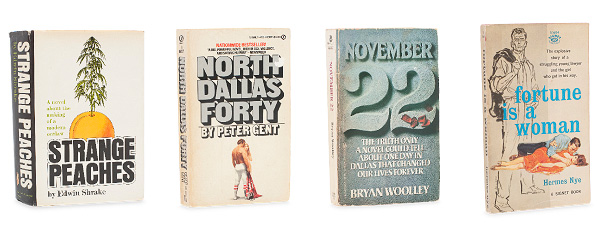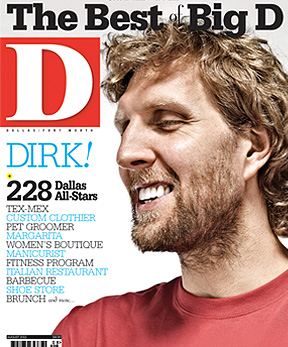Which brings us to the four serious contenders.
Fortune is a Woman
Like Jack Ruby, Hermes Nye came to Dallas from Chicago. But rather than a strip club owner and small-time hood, Nye was a low-powered divorce lawyer whose real avocation was as a folklorist, recording several acclaimed albums of Civil War ballads and Texas folk songs that are still available and popular, primarily in Germany. During the 1950s and ’60s, Nye was part of Dallas’ liberal underground. He lived by Lee Park back when the neighborhood was considered beatnik.

In 1958, he wrote a novel set in Dallas during the Great Depression called Fortune Is a Woman. If Nye himself wasn’t a man of big ambition, his protagonist, Paul Cotton, is downright ruthless in getting what he wants. He is a young lawyer, six months out of law school, working for free and living at the downtown YMCA. He runs through several women, the last of whom is even more ruthless than he is. She has another boyfriend whom she shoots and then plays Paul for a sap by getting him to bail her out and then bolting without even saying goodbye. In the end, Paul gets everything he has wanted, but he’s so disgusted with himself that he tries jumping out of his office window, only to be stopped by his friends, who convince him to give life another try.
Plot is not Nye’s strong point. Fortune Is a Woman is really just a string of vignettes heading in the general direction of a conclusion. But it’s an enjoyable ride. Nye takes you all over the city, to places you don’t know on streets you do. Along the way, he cracks wise, delivering lines like: “I was feeling the quaint exultation of the voyeur, the seer, the mad driving guilt that makes a great detective or a good credit manager.”
Nye wrote Fortune Is a Woman just as the old, funky Dallas he’d known in the 1930s was getting torn down and replaced by parking lots and glass-sheathed skyscrapers. Nye wanted to remember a city where most people lived downtown, dressed well even if they couldn’t afford it, and got around on streetcars. Those who could afford cars invariably kept a couple of Indian blankets in their trunks in case an opportunity presented itself for sex in the bushes, which repeatedly happens in Nye’s book.
Fortune Is a Woman’s greatest virtue may simply be that, having been written before the Kennedy assassination, it is untainted and unfettered by that event, allowing us to see Dallas when it was just another American city.
Strange Peaches
Edwin “Bud” Shrake was already famous in 1972 when he wrote Strange Peaches, his sprawling, hallucinogenic novel set in Dallas at the time of the Kennedy assassination. Besides being one of Sports Illustrated’s literary sportswriters, Shrake had written several novels and screenplays and was a founding member of Mad Dog Inc., the legendary cabal of fun-loving, hard-partying Texas writers, politicians, and musicians that included Gary Cartwright, Peter Gent, Dan Jenkins, Larry L. King, Willie Nelson, Jerry Jeff Walker, and future governor Ann Richards. But before he was all that, Shrake was a sports reporter in Dallas. He knew the city and nearly everybody in it, including Jack Ruby, who is a character in his book. In fact, at the time of the assassination, Shrake was dating a woman named Jada, one of Ruby’s strippers, which caused the hot-headed, pill-popping Ruby to pick a fight with Shrake several days before the shooting.
The way Shrake describes Dallas at the time, everybody here was popping pills, drinking, smoking dope, and having sex with each other. The book is nonstop debauchery, with occasional breaks taken to remember earlier sex acts and failed marriages. No character is particularly likeable, including the protagonist, John Lee Wallace, a TV cowboy who abruptly hangs up his spurs to come home to Dallas and make a documentary about “what’s really going on.” Mostly what he and his photographer buddy, Buster, film is arbitrary moments that don’t add up to anything. But then, almost by accident, they find themselves filming the Kennedy motorcade. Wallace and the president lock eyes for a very long moment. Then the shots ring out, and Buster’s camera catches Kennedy’s skull being blown apart. Later, they realize, it also captures several of the gunmen in the background. They develop the film and show it to their friends, but then it all gets eaten by a goat someone left in his apartment.
Although Strange Peaches is still considered by some to be the greatest novel written about Dallas, reading it today, it’s hard not to wonder if the editors were so in awe of Shrake’s reputation that they couldn’t bring themselves to actually edit. It offers plenty of memorable vignettes and excellent writing, but there’s so much self-indulgence that gets in the way.
North Dallas Forty
Of all the novels set in Dallas, by far the best known is Peter Gent’s North Dallas Forty. Though it takes place in Dallas and does brilliantly capture the crazy toxicity of the city in the late 1960s, it is primarily a novel about football, not Dallas. It is a funny but extremely bitter and angry book about how professional football, particularly the never-named Dallas Cowboys, treats its players as nothing but pieces of equipment. They’re drugged up so they can play through injuries and pain, chewed up, and then spit out the moment they’re no longer useful. The way Gent, a former Cowboys player, writes it, there is no real dividing line between Dallas the team and Dallas the city. While he still has some love of the game, he has nothing but negativity for Dallas the city. This negativity might help make North Dallas Forty The Great Football Novel, but it prevents it from being The Great Dallas Novel. A novel can’t be this unrelentingly negative and hope to capture the essence of Dallas. Nobody would ever pretend this is a city without foibles. Our most noteworthy one might be our endless positivism. If you’re going to attack it, you can use a barbed lance or a bazooka but not a steamroller, which is what Gent does.
November 22
The closest thing we have to The Great Dallas Novel is Bryan Woolley’s November 22, published in 1982 (not to be confused with Adam Braver’s 2008 novel, November 22, 1963, a far lesser work). Woolley’s book is a big, yet restrained, novel that takes place over the 24 hours of the day Kennedy was killed. It has a wide cast of characters that includes an H.L. Hunt stand-in, one of his bankers; the liberal Irish Catholic wife of an insurance company executive just moved down from Connecticut; a state senator from the Hill Country hoping to meet the president at the Dallas Trade Mart luncheon; and a Jack Ruby stand-in and one of his strippers, whom he’s rented out to the state senator. There are cops and reporters, actors, estranged wives, right-wing society matrons, a black cab driver, and a couple of winos who witness the assassination but still manage to miss the whole thing. The characters’ paths endlessly cross and recross throughout the book.
What is remarkable about Woolley’s book is its balance. Some of the characters are bigoted nut jobs, but most are just people, some good, some bad. Like Bud Shrake, Woolley was a Dallas reporter (at the Times Herald and Morning News). But unlike Shrake, he wasn’t in Dallas when JFK was shot. He may not have personally known Jack Ruby, but he got around and heard all the stories, and, in that sense, he used his own distance from the event to his advantage. Though the book was successful enough to be reprinted into paperback, it got the cold shoulder in Dallas. Woolley told me that a lot of Dallas bookstores, rather than risk angering customers, stocked his book under the counter.
Looking back at Dallas during the 1960s, Woolley wonders if people today grasp just how vicious the atmosphere was. Seeing the recent rise of political absolutism, he worries that what poisoned Dallas then might now be spreading across the country. Woolley is in discussions with an e-book publisher. Soon enough, he hopes, November 22 will still be out of print but available once again, this time in electronic form.
Dallas isn’t quite the Big City it was in the past. Certainly it’s larger now, but the grand oligarchs like H.L. Hunt and R.L. Thornton and Bob Cullum have all left the stage, and the ones who’ve replaced them, CEO transplants from other parts of the country, couldn’t be bothered with running the city. But Dallas will always be a city of Scotsmen on the make whose ambitions and sense of entitlement will sooner or later become the target of someone with a bit of literary imagination and a finely barbed pen.
Brendan McNally’s newest novel, Friend of the Devil, is now out on Kindle. Visit brendanmcnallyauthor.com.






